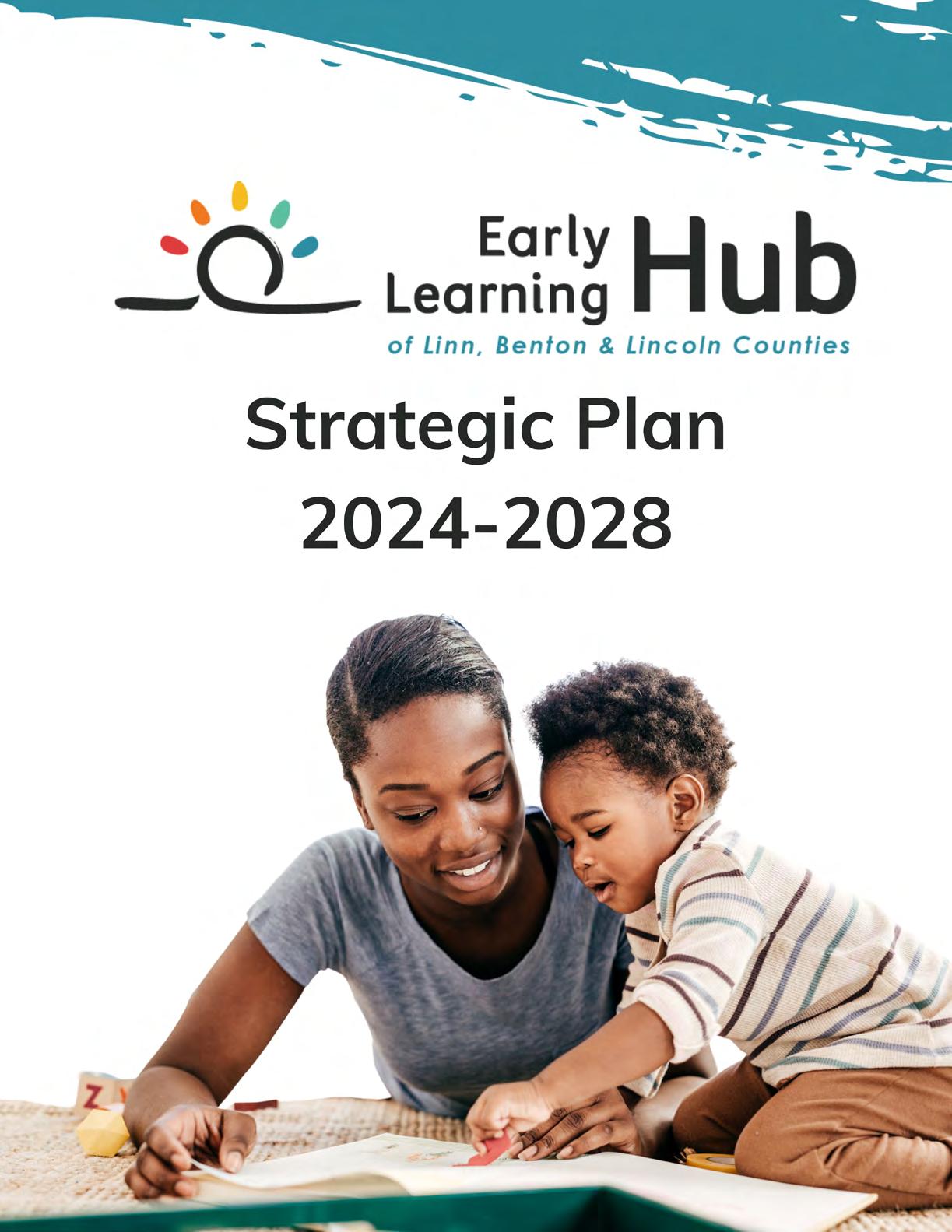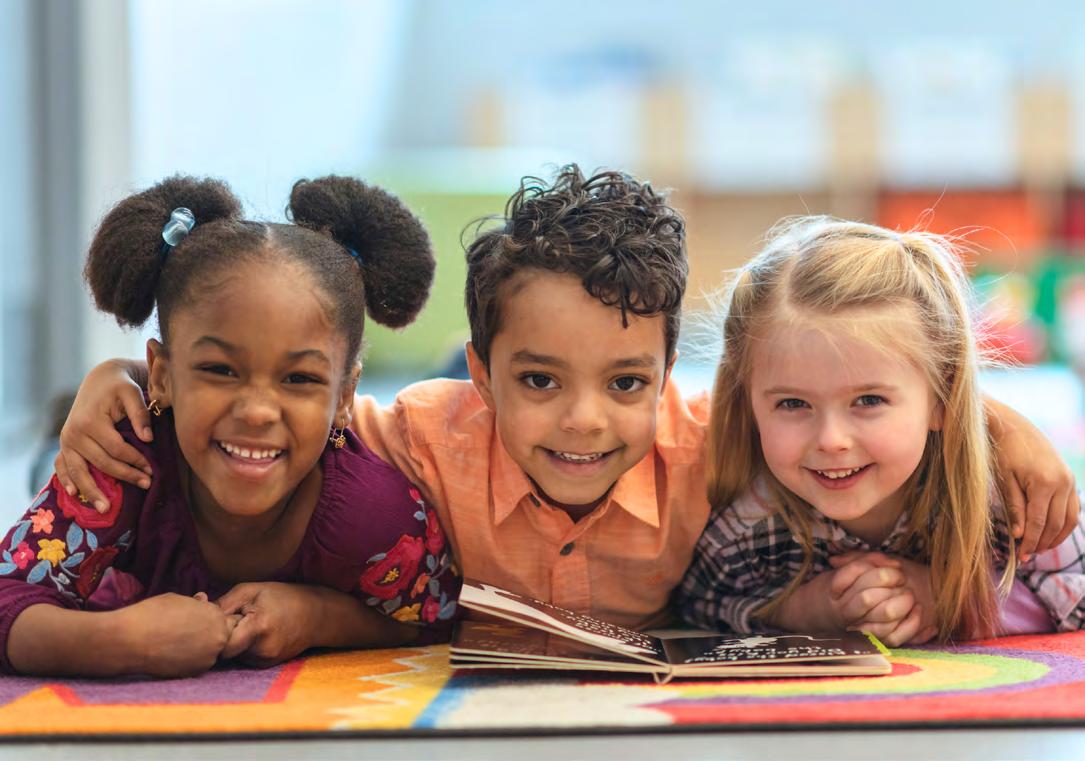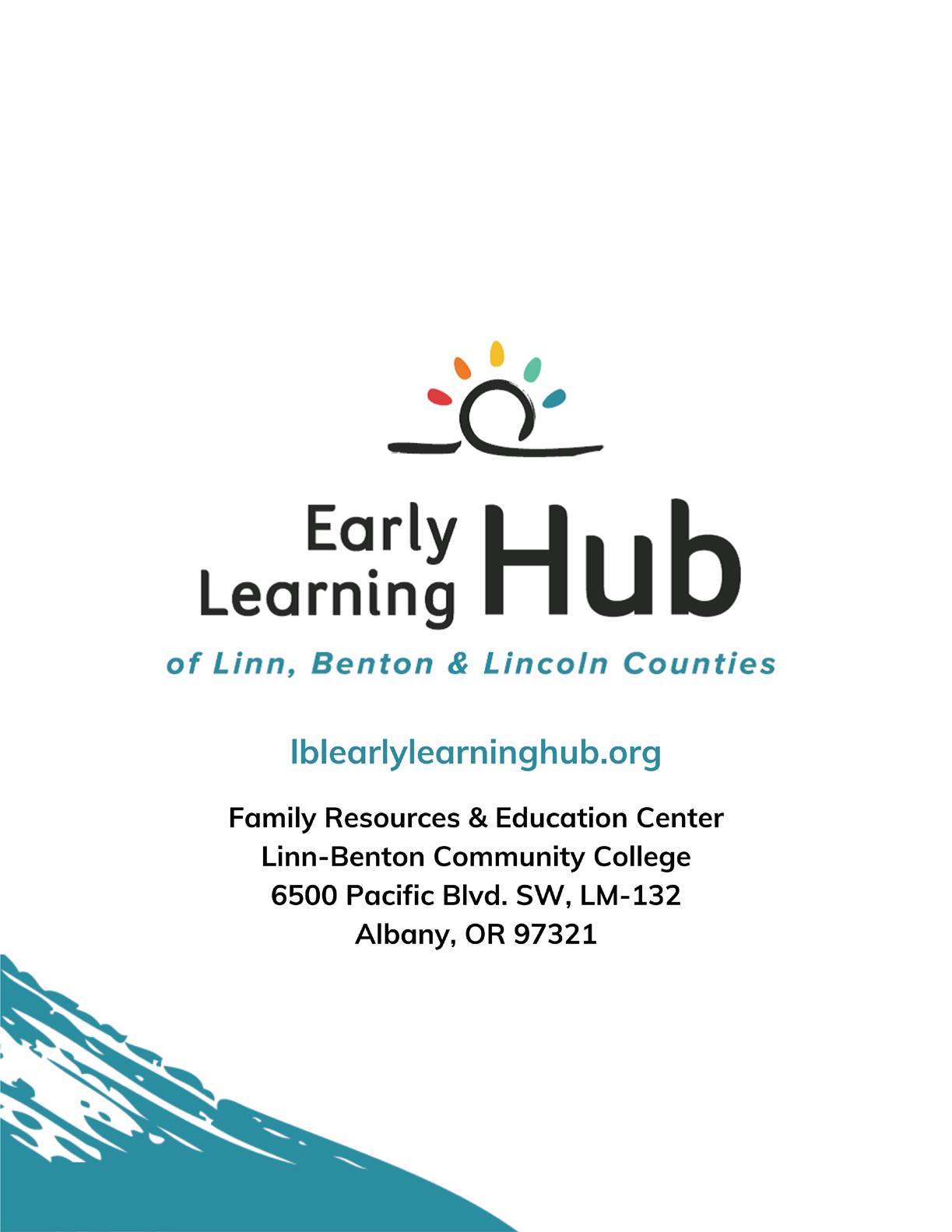Letter from the Director:
Dear Community Members of Linn, Benton & Lincoln Counties,
I wanted to take a moment to thank the many partners and community members who have given of their time and knowledge in the development of our new Strategic Plan. The last several months have included many partners coming together with EL Hub staff as we identified community priorities in alignment with Raise Up Oregon, developed goals related to those priorities, and developed our own regional strategies for how we will collectively work to achieve those goals. Thank you to everyone who has been involved in this process.
We are at an exciting time as an Early Learning Hub. March 2025 will mark our official 10th anniversary! This upcoming anniversary gives us an opportunity to reflect on our work and achievements over the last 10 years, as well as the opportunity to set goals of what we hope to accomplish in the next 10 years in our region as we work to support children and families. This is work that cannot and should not be done in isolation. We are stronger as a collective, and I am proud to be a part of the shared commitment to this work with all agencies and programs that strive to make the communities in Linn, Benton, and Lincoln Counties better for families.
I look forward to our ongoing partnerships as we work towards the implementation of our Strategic Plan.
Kristi Collins Early Learning Hub Director
Background
The Early Learning Hub of Linn, Benton & Lincoln Counties supports underserved children and families in our region to learn and thrive by making resources and supports more available, more accessible, and more effective.
The Early Learning Hub is a collection of program and service providers who believe that by working together as K-12 schools, early education, health, human services, and business we can better serve children and families.
We are focused on young children and their families because research is clear that giving children a strong start helps set them on a path toward future success, in school and in life. Well before the start of kindergarten, a child’s brain has already created the foundation for future learning and development. The more we invest in young children, the greater the payoff will be down the road with stronger readers in third grade, more high school graduates, more college-ready students, and a skilled workforce that has the social, emotional and cognitive skills needed to meet the demands of a rapidly changing economy and contribute to our shared prosperity.
If our Early Learning Hub is successful, we will see more children ready to succeed in kindergarten, more families with the resources and tools to create stable environments for their children, and services and programs working together to provide what children and families need most.
Guiding Principles
The Hub and its governance Councils shall operate under the following guiding principles in fulfilling the vision, mission and outcome goals of an Early Learning Hub:
• There are several places where families and organizations cross the three counties, providing opportunities for systems alignment and coordination.
• We will strive to create community-specific strategies, since needs and programs differ across counties and communities.
• We respect and value our existing relationships and will seek to expand our partnerships and build new relationships.
• Oregon’s Early Childhood System’s Theory of Change will guide our work with a focus on collaborative action that leads to systems changes.
• We seek to create a Hub that is inclusive and transparent with processes and procedures that are as stream-lining as much as possible.
• Our governance model will evolve over time, and will be evaluated and adjusted to strategically meet outcomes.
Raise Up Oregon
Raise Up Oregon: A Statewide Early Childhood System Plan 2024-2028 is a statewide strategic plan focused on actions that state agencies can use in partnership with families, communities, and the private sector to build a comprehensive early childhood system that achieves the following vision and goals:
Vision: All of Oregon’s young children, prenatal to age five, experience an early start that results in positive health, education, and life outcomes regardless of zip code, race, and family income.
System Goal 1: The early childhood system is equitable: integrated, accessible, inclusive, anti-racist, and family centered.
System Goal 2: All families with young children are supported to ensure their well-being.
System Goal 3: All children are thriving in early childhood and beyond.
The early childhood system includes the full set of supports that young children and their families need to grow and thrive. These supports include the areas of physical and mental health, housing, social services, and early learning and care. Because a comprehensive early childhood system must address all these domains and do so in a way that respects and empowers families, Raise Up Oregon calls out the specific and collaborative contributions that multiple agencies must commit to building this system.
These agencies include the Department of Early Learning and Care (DELC), Higher Education Coordinating Commission (HECC), Oregon Department of Education (ODE), Oregon Department of Human Services (ODHS), Oregon Health Authority (OHA), and Oregon Housing and Community Services (OHCS).
Raise Up Oregon At a Glance
System Goal 1: The early childhood system is equitable: integrated, accessible, inclusive, anti-racist, and family centered.
Objective 1: Honor and recognize the sovereignty of the nine federally recognized tribal nations within Oregon and ensure strong government-to-government relationships to benefit tribal communities.
Objective 2: Multi-agency partnerships are developed at the state and local levels to systematically support improved outcomes and streamlined access for all young children and their families.
Objective 3: Early Learning Hubs are leveraged and resourced to advance regional early childhood systems that are equitable, integrated, accessible, inclusive, and family centered.
Objective 4: The business, philanthropic, and non-profit communities champion and support the development of the early childhood system.
System Goal 2: All families with young children are supported to ensure their wellbeing.
Objective 5: Families with young children are supported in knowing about and accessing a full range of services that meet their needs and are culturally and linguistically responsive.
Objective 6: Families with young children have increased access to economic supports.
Objective 7: All families have access to support for their physical, social, emotional, behavioral, and oral health.
Objective 8: Families have expanded access to culturally and linguistically responsive and specific family preservation strategies, resources, and programs focused on the prenatal-to-five population.
Objective 9: Affordable housing is available statewide for all families with young children.
Objective 10: All parents and families are supported and engaged in enabling their children to thrive
System Goal 3: All children are thriving in early childhood and beyond.
Objective 11: Families have access to high-quality, culturally, and linguistically responsive birth-to-five pediatric health care services.
Objective 12: Families have access to high-quality, culturally, and linguistically responsive birth-to-five social and emotional supports.
Objective 13: Young children with developmental delays and disabilities are identified early and provided with inclusive services to reach their full potential.
Objective 14: Families have access to high-quality (culturally responsive, inclusive, developmentally appropriate) and affordable early learning and care that meets their needs.
Objective 15: The early childhood workforce is diverse, culturally responsive, high quality, and well compensated.
Objective 16: Children and families experience supportive transitions and continuity of services across early learning and care and public education (K-12) settings.
Early Learning System Goal 1: The Early Learning System is equitable: integrated, accessible, inclusive, anti-racist, and family centered.
Regional Goal #1:
Hub Strategies:
The business, philanthropic, and non-profit communities champion and support the development of the early childhood system throughout the region.
Strategy 1.1: Educate local businesses on the importance of child care and its impact on their employees through the Business Outreach Initiative.
Strategy 1.2: Work with local businesses to identify solutions to the child care issues their employees face and how to build supports into their budget for both short- and long-term solutions.
Strategy 1.3: Serve as the regional host for the Best Place for Working Parents certification initiative working with local chambers and workforce development boards to market the certification throughout the region.
Raise Up Oregon Alignment:
This goal and the strategies for implementation align with and support Raise Up Oregon Objective 4.
Regional Goal #2: Pollywog will serve as a regional referral system for health-related social needs. (pending grant award)
Strategy 2.1: Pollywog will apply to IHN-CCO for the Community Capacity Building Funds.
Strategy 2.2: Pollywog will contract with or hire a medical biller.
Hub Strategies:
Raise Up Oregon Alignment:
Strategy 2.3: Staff will be trained as traditional health workers and position descriptions will be re-written to reflect the work required from the grant.
Strategy 2.4: Health-related social needs services and supports will be incorporated into existing Pollywog website, social media and marketing.
This goal and the strategies for implementation align with and support Raise Up Oregon Strategies 5.2 and 5.4.
Early Learning System Goal 2: All families with young children are supported to ensure their well-being.
Regional Goal #3: Families have access to an array of home visiting programs to meet their needs.
Strategy 3.1: Create a home visiting work group as a part of the Early Learning Hub governance structure that leverages an existing meeting time/format and includes all regional home visiting programs, regardless of funding stream or service delivery model.
Hub Strategies:
Strategy 3.2: Ensure that all home visiting programs in the region have access to Connect Oregon to send and receive referrals.
Strategy 3.3: Map all home visiting programs in the region with information regarding model type, eligibility requirements, length of program availability, etc. Create a Guidebook for Pollywog staff, health care providers, and other community partners.
Raise Up Oregon Alignment: This goal and the strategies for implementation align with and support Raise Up Oregon Strategies 2.6, 5.1, 5.4, 10.2 and 10.5.
Regional Goal #4: Connect Oregon (Unite Us) is utilized to its full potential as the region’s referral system.
Strategy 4.1: In partnership with Unite Us and InterCommunity Health Network (IHN), host trainings for community partners on the use of Connect Oregon specific to program type and need.
Hub Strategies:
Strategy 4.2: Support IHN in their roll out of Connect Oregon as the regions Community Information Exchange platform.
Raise Up Oregon Alignment: This goal and the strategies for implementation align with and support Raise Up Oregon Strategy 5.4.
Early Learning System Goal 3: All children are thriving in early childhood and beyond.
Regional Goal #5: Children with developmental delays and disabilities have access to high-quality, inclusive, early childhood programs.
Hub Strategies:
Strategy 5.1: Pilot mixed delivery classroom model in partnership with Corvallis School District, Early Intervention/Early Childhood Special Education, and Head Start/ Kids and Company for inclusive preschool classrooms at 7 of 8 elementary schools within the district. Embed a philosophy of shared professional development that includes preschool staff and early grade teachers together.
Strategy 5.2: Assess pilot for potential replication while sharing success and challenges with all school districts in our region.
Raise Up Oregon Alignment: This goal and the strategies for implementation align with and support Raise Up Oregon Strategies 13.3 and 14.7.
Regional Goal #6: The early learning and care workforce will have access to an array of professional development opportunities to best support the children and families they serve.
Strategy 6.1: Support the Child Care Resource and Referral to increase coaching capacity in early learning and care environments, inclusive of all settings.
Strategy 6.2: Ensure that the home visiting workforce has access to professional development opportunities that address the unique challenges of home visiting.
Hub Strategies:
Strategy 6.3: Increase access to professional development opportunities in multiple languages to meet the diverse needs of the workforce.
Strategy 6.4: Increase access to shared professional development opportunities that includes both early learning providers and early grade teachers together.
Raise Up Oregon Alignment: This goal and the strategies for implementation align with and support Raise Up Oregon Strategies 10.4, 12.1, 14.4, and 16.2.
Regional Goal #7: Children and families experience supportive transitions and continuity of services across early learning and care and public education. (K-12) settings.
Strategy 7.1: Increase awareness of Kindergarten round up events by leveraging CCR&R’s relationships with Child Care providers to help share information with families.
Strategy 7.2: Work with Early Learning providers and kindergarten teachers to develop a “Transition to Kindergarten” toolkit.
Hub Strategies:
Raise Up Oregon Alignment:
Strategy 7.3: Explore potential of Early Learning data being tracked in K-12 data system.
Strategy 7.4: Advocate for a single fingerprint process for early learning professional regardless of settings (e.g. preschool, K-12).
Strategy 7.5: Leverage P-3 Alignment workgroup to identify and share best practice strategies related to transition activities and supports.
This goal and the strategies for implementation align with and support Raise Up Oregon Objective 16.
Regional Goal #8: Families have access to high-quality, culturally and linguistically responsive birth-to-five social and emotional supports. (IECMHC Grant)
Strategy 8.1: Support CCR&R in the development of their community engagement plan for their Infant & Early Childhood Mental Health Consultation grant.
Hub Strategies:
Raise Up Oregon Alignment:
Strategy 8.2: Support CCR&R in developing collaborative relationships with early learning system partners. Help to identify new or additional partners that need to be included in the work.
Strategy 8.3: Serve as convener with CCR&R and regional early learning system partners to support development of processes and agreements for “teaming” Warmline request.
This goal and the strategies for implementation align with and support Raise Up Oregon Strategy 12.2.
Early Learning Hub Governing Board
Claire Hall, Co-Chair
Lincoln County Commissioner
Lincoln County – Human & Social Services
Lola Jones, Co-Chair
Samaritan House Lincoln County – Housing
DeAnn Brown
Confederated Tribes of Siletz Indians Standing Position
Belit Burke
Oregon Department of Human Services ODHS – Standing Position
Jeff Davis
Linn-Benton Community College Fiscal Agent – Standing Position
Shelagh Baird
Samaritan Health Services
Lincoln County – Health
Dean Craig
Willamette Workforce Partnership
Linn County – Business
Barbara Dougherty
Samaritan Early Learning Center, retired
Lincoln County – Early Childhood Education
Laura Farmer
Parent
Benton County – Parent Voice
Susan Halliday Philomath School District Benton County – K-12
Jason Hay Linn Benton Lincoln Education Service District Standing Position
Todd Jeters
InterCommunity Health Network (IHN) Coordinated Care – Standing Position
Stephany Koehne Kids & Company of Linn County Linn County – Early Childhood Education
Steve Martinelli Scio School District Linn County – K-12
Bettina Schempf Old Mill Center Benton County – Human & Social Services
Paul Smith
Strengthening Rural Families
Benton County – Early Childhood Education
Diane Wilkinson
Lincoln County School District
Lincoln County – K-12
Lynnette Wynkoop
Child Care Resource & Referral CCR&R Standing Position






